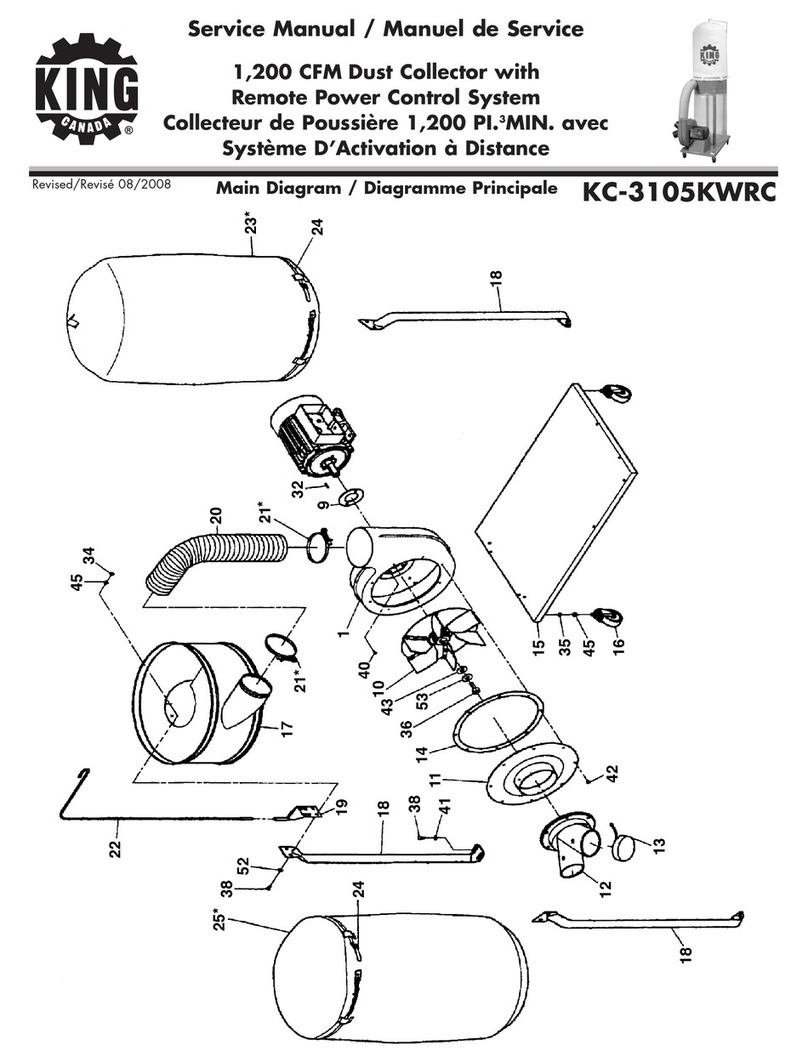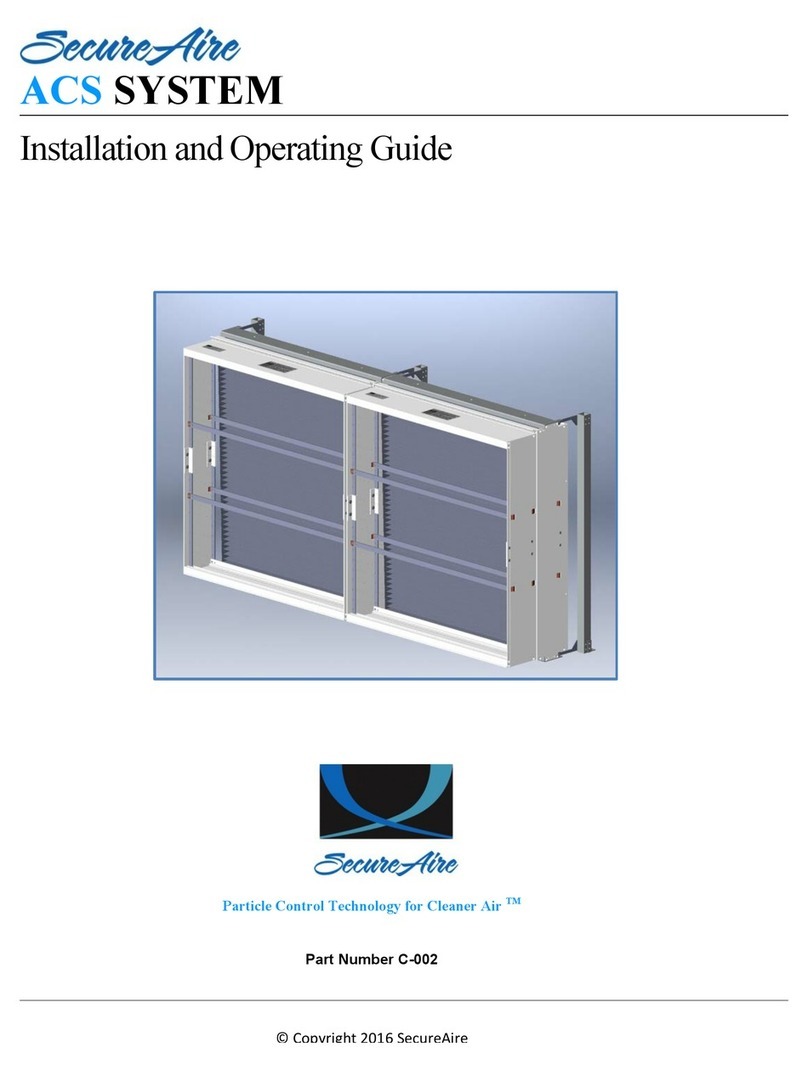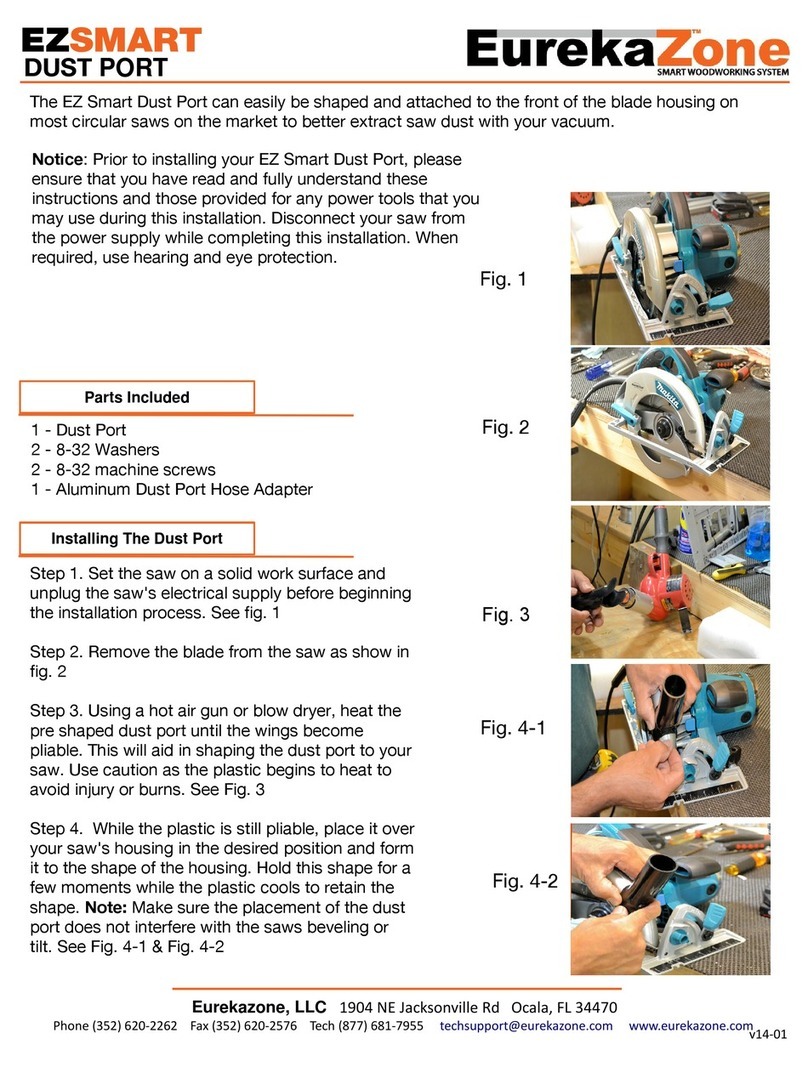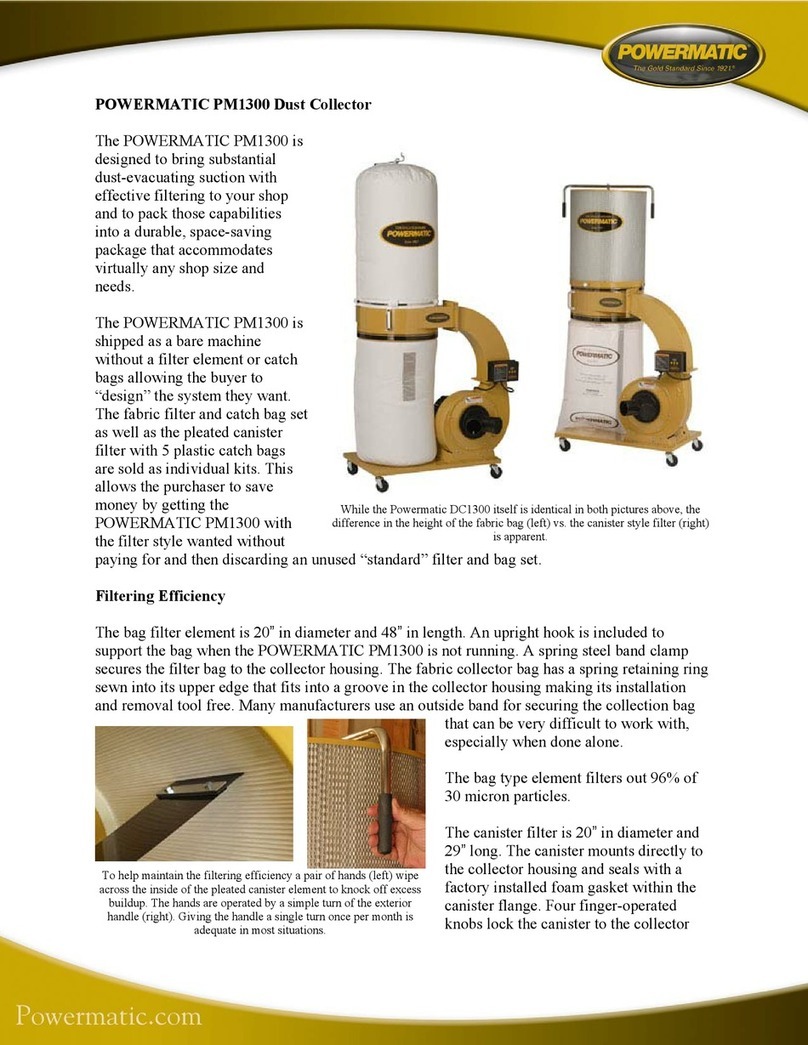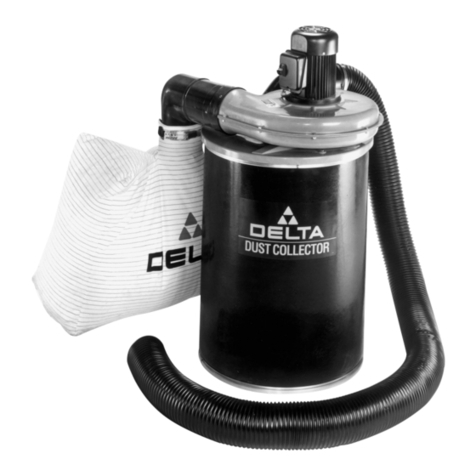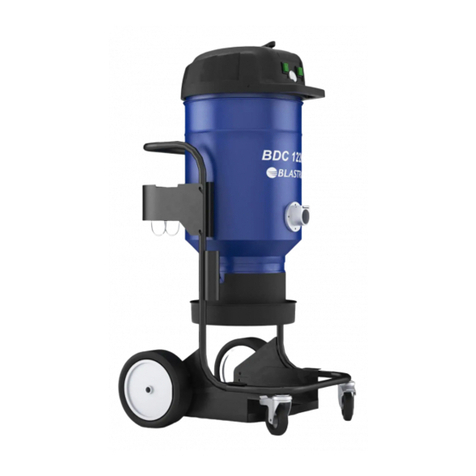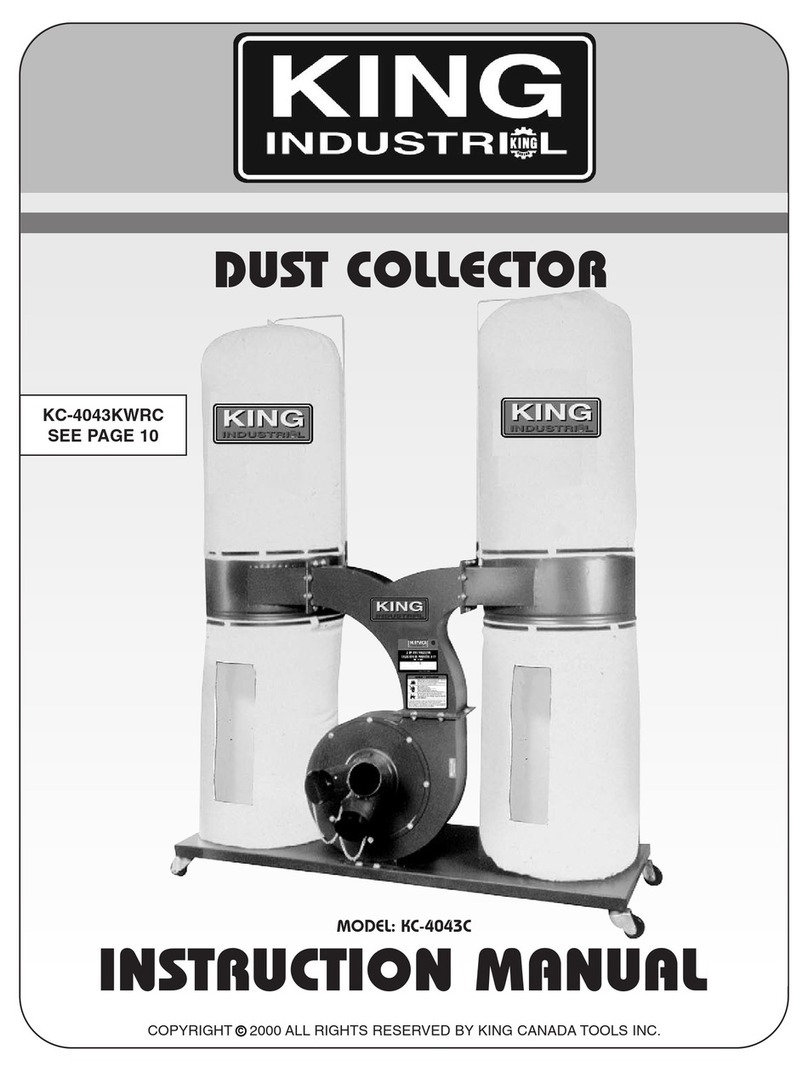TSI Instruments PAN231 Series Operation manual

POSITIVE AND NEGATIVE DUCT
ACCREDITATION (PANDA) SYSTEM
MODEL PAN231 SERIES
(PANDA LIGHT)
OPERATION AND SERVICE MANUAL
P/N 6006886, REVISION C
JULY 2017
www. .com information@itm.com1.800.561.8187

ii
www. .com information@itm.com1.800.561.8187

iii
Copyright©
TSI Incorporated / 2013–2017 / All rights reserved.
LIMITATION OF WARRANTY AND LIABILITY (effective February 2015)
Seller warrants the goods, excluding software, sold hereunder, under normal use and
service as described in the operator's manual, to be free from defects in workmanship
and material for 24 months, or if less, the length of time specified in the operator's
manual, from the date of shipment to the customer. This warranty period is inclusive of
any statutory warranty. This limited warranty is subject to the following exclusions and
exceptions:
a. Hot-wire or hot-film sensors used with research anemometers, and certain other
components when indicated in specifications, are warranted for 90 days from the date
of shipment;
b. Pumps are warranted for hours of operation as set forth in product or operator’s
manuals;
c. Parts repaired or replaced as a result of repair services are warranted to be free from
defects in workmanship and material, under normal use, for 90 days from the date of
shipment;
d. Seller does not provide any warranty on finished goods manufactured by others or on
any fuses, batteries or other consumable materials. Only the original manufacturer's
warranty applies;
e. This warranty does not cover calibration requirements, and seller warrants only that
the instrument or product is properly calibrated at the time of its manufacture.
Instruments returned for calibration are not covered by this warranty;
f. This warranty is VOID if the instrument is opened by anyone other than a factory
authorized service center with the one exception where requirements set forth in the
manual allow an operator to replace consumables or perform recommended
cleaning;
g. This warranty is VOID if the product has been misused, neglected, subjected to
accidental or intentional damage, or is not properly installed, maintained, or cleaned
according to the requirements of the manual. Unless specifically authorized in a
separate writing by Seller, Seller makes no warranty with respect to, and shall have no
liability in connection with, goods which are incorporated into other products or
equipment, or which are modified by any person other than Seller.
The foregoing is IN LIEU OF all other warranties and is subject to the LIMITATIONS
stated herein. NO OTHER EXPRESS OR IMPLIED WARRANTY OF FITNESS FOR
PARTICULAR PURPOSE OR MERCHANTABILITY IS MADE. WITH RESPECT TO
SELLER’S BREACH OF THE IMPLIED WARRANTY AGAINST INFRINGEMENT,
SAID WARRANTY IS LIMITED TO CLAIMS OF DIRECT INFRINGEMENT AND
EXCLUDES CLAIMS OF CONTRIBUTORY OR INDUCED INFRINGEMENTS.
BUYER’S EXCLUSIVE REMEDY SHALL BE THE RETURN OF THE PURCHASE
PRICE DISCOUNTED FOR REASONABLE WEAR AND TEAR OR AT SELLER’S
OPTION REPLACEMENT OF THE GOODS WITH NON-INFRINGING GOODS.
TO THE EXTENT PERMITTED BY LAW, THE EXCLUSIVE REMEDY OF THE USER
OR BUYER, AND THE LIMIT OF SELLER'S LIABILITY FOR ANY AND ALL LOSSES,
INJURIES, OR DAMAGES CONCERNING THE GOODS (INCLUDING CLAIMS
BASED ON CONTRACT, NEGLIGENCE, TORT, STRICT LIABILITY OR OTHERWISE)
SHALL BE THE RETURN OF GOODS TO SELLER AND THE REFUND OF THE
PURCHASE PRICE, OR, AT THE OPTION OF SELLER, THE REPAIR OR
REPLACEMENT OF THE GOODS. IN THE CASE OF SOFTWARE, SELLER WILL
REPAIR OR REPLACE DEFECTIVE SOFTWARE OR IF UNABLE TO DO SO, WILL
REFUND THE PURCHASE PRICE OF THE SOFTWARE. IN NO EVENT SHALL
SELLER BE LIABLE FOR LOST PROFITS, BUSINESS INTERRUPTION, OR ANY
www. .com information@itm.com1.800.561.8187

iv
SPECIAL, INDIRECT, CONSEQUENTIAL OR INCIDENTAL DAMAGES. SELLER
SHALL NOT BE RESPONSIBLE FOR INSTALLATION, DISMANTLING OR
REINSTALLATION COSTS OR CHARGES. No Action, regardless of form, may be
brought against Seller more than 12 months after a cause of action has accrued. The
goods returned under warranty to Seller's factory shall be at Buyer's risk of loss, and will
be returned, if at all, at Seller's risk of loss.
Buyer and all users are deemed to have accepted this LIMITATION OF WARRANTY
AND LIABILITY, which contains the complete and exclusive limited warranty of Seller.
This LIMITATION OF WARRANTY AND LIABILITY may not be amended, modified or its
terms waived, except by writing signed byan Officer of Seller.
Service Policy
Knowing that inoperative or defective instruments are as detrimental to TSI as theyare
to our customers, our service policy is designed to give prompt attention to any
problems. If any malfunction is discovered, please contact your nearest sales office or
representative.
Trademarks
TSI and TSI logo are registered trademarks of TSI Incorporated.
Airflow is a trademark of TSI Incorporated.
www. .com information@itm.com1.800.561.8187

v
CONTENTS
CHAPTER 1 UNPACKING AND PARTS IDENTIFICATION.............1
CHAPTER 2 PREPARING PAN231 SYSTEM FOR AIR DUCT
LEAK TESTING...................................................................................5
CHAPTER 3 PERFORMING A DUCT LEAKAGE TEST ................11
Measuring Duct Static Pressure...................................................11
Measuring Duct Leakage Flow.....................................................12
Turning on the PAN231 Duct Leakage Tester..............................12
Using Leakage Test Application in the Model 9565-P..................12
Troubleshooting Guide .................................................................16
APPENDIX A SPECIFICATIONS.....................................................17
APPENDIX B LEAKAGE TESTING STANDARDS HIGHLIGHTS ...21
Standards Supported....................................................................21
EU Standards ...............................................................................22
US Standards ...............................................................................25
APPENDIX C TYPICAL SETUP.......................................................29
www. .com information@itm.com1.800.561.8187

1
Chapter 1
Unpacking and Parts Identification
Carefully unpack the PANDA system and instrument cases from the
shipping container. Check the individual parts against the list of
components below. If anything is missing or damaged, notify TSI
immediately.
The PANDA system consists of the following:
Qty
Description
Part Number
Reference Picture
1
Low flow nozzle
6002598
1
Primary duct adapter
spigot plus rubber bung
(to fit to test duct)
6002638
1
Cam lock primary spigot
(to connect flexi
-
duct to
PANDA)
6002607
2
Ø4-in. (100-mm)
adjust
able over lock
straps
6002683
1
13-ft (4-m) long
Ø
4-in. (100-mm)
plastic
flex
ible duct
6002667
2
20-in. (500-mm) silicone
tubes (red)
AFL9020004
www. .com information@itm.com1.800.561.8187

2 Chapter 1
Qty
Description
Part Number
Reference Picture
2
20-in. (500-mm) silicone
tubes (blue)
AFL9020005
1
16-ft (5-m) silicone tube
(blue)
AFL9020005
1
K-type thermocouple
probe
AFL82859201
3
Instrument adapter
AFL82859401
1
Instrument box
6006490
1
Flex Duct Carry Tube
6006491
1
Operation and Service
manual
6006886
www. .com information@itm.com1.800.561.8187

3
The following two instruments should be used in conjunction with the
PANDA unit:
9565
-P Multi-
function
Instrument
Refer to
9565
Operation and Service
Manual supplied with the instrument
for additional parts supplied as
standard.
5815
Micromanometer
Refer to
5815
Operation and Service
Manual supplied with the instrument
for additional parts supplied as
standard.
(continued on next page)
www. .com information@itm.com1.800.561.8187

4 Chapter 1
IMPORTANT—
Read Before Using the PANDA for the First Time
It is
IMPORTANT that the 110V PANDA (yellow power socket) be
connected
only to 110V to 120V supplies. Connecting it to a hi
gher
voltage supply will permanently damage the inverter.
The 220V/240V
PANDA (blue power socket) should only be
connected to 200V to 240V
power supplies.
When storing the
PANDA
in a vertical position, please ensure that the
straps holding the instrument b
ox are in place and tightened first.
The
PANDA
is designed so that the Instrument box and duct carry
tube are removable to lighten the load when lifting.
www. .com information@itm.com1.800.561.8187

5
Chapter 2
Preparing PAN231 System for Air Duct
Leak Testing
Carefully follow the procedures below to achieve safe and accurate
leakage testing:
Successfully completing a duct leakage test requires compiling
certain informatio
n prior to starting the test. Refer to
Appendix
B for a discussion of standards relating to duct
leakage testing. The list below indicates the information
required:
x
Type of leakage test to be performed (positive or
negative).
x
Leakage standard to be followed.
x
Air tightness/leakage class to be achieved.
x
Amount of ductwork to be tested, such as t
he complete
system or a statistical sample.
1. Select the section of the ductwork to be tested.
2. Calculate the surface area of the ductwork of the section to
be tested.
3. Temporarily seal all the openings of the ductwork except one,
which will be connected to the PAN231 duct leakage tester.
4. Position the PAN231 unit as close to the remaining opening in the
ductwork as possible to minimize the flexible tubing needed.
Minimize bends in the flexible tubing to reduce the pressure loss,
giving the best performance.
5. Make sure the Fan Run/Stop Switch on the Fan Speed Controller
is in the Stop position and the multi-turn Fan Speed Control
potentiometer is fully turned counter-clockwise using the picture
of the VFD in Figure 1 as a reference. Plug the cord into the
PANDA unit as shown in Figure 2 and Figure 3. Then connect the
other end of the cord to a suitable electrical supply.
CAUTION
Remove the power cord from the PANDA duct leakage tester before
tilting it to the vertical position to avoid damaging the cord.
www. .com information@itm.com1.800.561.8187

6 Chapter 2
Fan Speed Control
Fan Run/Stop Switch
Figure 1. Fan Speed Controller
Note:
The settings for the inverter have been locked and cannot be
changed using the key pad.
Figure 2. Receptacle for
Power Cord
Figure 3.
Connected Power Cord
Note:
The 110V unit has a yellow receptacle and the 230V unit has
a blue receptacle.
www. .com information@itm.com1.800.561.8187

Preparing PAN341 System for Air Duct Leak Testing
7
6.
Fit the primary duct adapter
spigot (black sheet metal
with
rubber bung) to one end of the
4-in. (100-mm)
diameter flexi-
tube. Make an air-tight seal
using one of the over lock
straps and lever-
locking cam
provided as shown in
Figure 4.
Adjust the fit of the over lock
strap with a screwdriver.
7.
Securely attach the black
primary duct adapter
spigot/flexi-tube assembly
to
the opening
on the ductwork
to be pressure tested.
Figure 4. Flex Ductwork
Connected to Primary Adapter
Spigot. Bung not shown.
8.
If
the static pressure tap on the
black Primary Duct Adapter
is
open to the duct, c
onnect the
16-ft (5-m) long blue silicone
tube to it as shown in
Figure 5.
If the static pressure tap on the
black Primary Duct Adapter
is
not open to the duct, drill a
4-mm hole in the duct and
insert about 6 inches (10 mm
)
of the silicone tube into the
duct. Seal around the hole
with putty.
9.
Connect the other end of the
4-in. (100-mm) flexi-tube to
the
cam lock connector (gray cast
Figure
5. Co
nnecting Pressure
Tubing to Tap on Primary Duct
Adapter.
Bung not shown.
aluminum without nozzle). Make an airtight seal using the other
over lock strap (not shown) and lever-locking cam provided.
Adjust the fit of the over lock strap with a screwdriver.
www. .com information@itm.com1.800.561.8187

8 Chapter 2
10.
Determine if you are going to perform a high- or low-
flow testing
and positive or negative testing. Set-up the duct leakage
tester by:
a.
For positive pressure, high-
flow testing, remove the
low flow nozzle if it is
installed. Then, conn
ect
the gray cast-
aluminum
cam lock connector to the
outlet side of the blower
per Figure 6.
Close both
cam lock arms at the same
time to ensure proper fit.
Connect the free end of the
static pressure 16-ft (5-
m)
silicone tube to the
positive
pressure conn
ector on the
5815.
Cam Lock
Connector Fan Outlet
Figure 6. Positive P
ressure,
High-Flow Setup
Finally, connect the FLOW GRID pressure taps marked
P1(+) and P2(-) to the appropriate connectors on the
9565-P
using the red and blue tubing.
b. For positive pressur
e, low-
flow testing, add the low
-
flow nozzle to the blower
inlet if it is not installed per
Figure 7
. Then, connect
the gray cast-
aluminum
cam lock connector to the
outlet side of the blower
per Figure 6.
Close both
cam lock arms at the same
time to ensure
proper fit.
Connect the free end of the
static pressure 16-ft (5-
m)
silicone tube to the positive
pressure connector on the
5815.
Low Flow
Nozzle
Fan Inlet
Figure 7.
Positive Pressure,
Low-Flow Setup
Finally connect the pressure taps marked P1(+) and P2(-
) on
the nozzle to the appropriate connectors on the 9565-P
using the red and blue tubing.
www. .com information@itm.com1.800.561.8187

Preparing PAN341 System for Air Duct Leak Testing
9
c. For negative pressure,
high-
flow testing, remove
the low flow nozzle if it is
installed. Then, connect
the gra
y cast aluminum
cam lock connector to the
inlet sid
e of the blower per
Figure 8
. Close both cam
lock arms at the same time
to ensure proper fit.
Connect the free end of
the
static pressure 16-ft (5-
m)
silicone tube
to pressure
connector on the 5815.
Fan Inlet
Cam Lock
Connector
Figure 8. Negative
Pressure,
High-Flow Setup
Finally connect the pressure taps marked P1(+) and P2(-
)to
the appropriate connector on the 9565-
P using the red and
blue tubing.
d.
For negative pressure, low-
flow testing, add the low
-
flow nozzle to the blower
inlet if it is not installed.
Then, connect the gray
cast aluminum cam lock
connector to the low-
flow
nozzle per Figure 9.
Close
both cam lock arms at the
same time to ensure
proper fit.
Connect the free end of the
static pressure 16-ft (5-
m)
silicone
tube to the positive
pressure c
onnector to the
5815.
Cam Lock
Connector
Fan Inlet
Low-Flow Nozzle
Figure 9.
Negative Pressure,
Low-Flow Set-Up
Finally connect the pressure taps marked P1(+) and P2(-
)on
the nozzle to the appropriate connectors on the 9565-P
using the red and blue tubing.
www. .com information@itm.com1.800.561.8187

11
Chapter 3
Performing a Duct Leakage Test
The PAN231 duct leakage test system includes a Model 5815
Micromanometer and a Model 9565-P Ventilation Meter. During duct
leakage testing, the Model 5815 Micromanometer measures the duct
static pressure while the Model 9565-P Ventilation Meter measures
the airflow rate.
Refer to the Operation and Service Manuals for the Model 5815
Micromanometer and the Model 9565-P Ventilation Meter to use
these instruments in other applications.
Measuring Duct Static Pressure
1. Turn ON the Model 5815.
2. Zero the Model 5815 pressure sensor with both ports open to
the atmosphere.
3. Connect the (+) port on the Model 5815 to measure the duct
static pressure (see Figure 5).
4. Leave the (-) port on the Model 5815 open to the atmosphere.
Note:
Refer to the Model 5815 Operation and Service Manual for
instruction on use.
www. .com information@itm.com1.800.561.8187

12 Chapter 4
Measuring Duct Leakage Flow
Turning on the PAN231 Duct Leakage Tester
1. Power the PANDA unit on by plugging in the power cord.
2. Position the Fan Control switch to the RUN position to energize
the fan.
3. Increase the fan to the desired speed by turning the Fan Speed
Controller clockwise. To decrease the fan speed, turn the Fan
Speed controller counter-clockwise.
Using Leakage Test Application in the Model 9565-P
CAUTION
The Model
5815 and Model 9565-
P meters must be zeroed before
e
ntering the Leakage Test Application.
1. Turn ON Model 9565-P.
2.
Zero the Model 9565-P
pressure sensor with both
ports open to the atmosphere.
3.
Connect the Model 9565-
P to
the PAN231
by connecting the
(+) and (-
) ports on the Model
9565-P to the P1 (+) and
P2
(+)
ports located on the inside
edge of the bo
x shelf facing
the fan. See Figure 10.
4.
Connect the thermocouple to
the Model 9565-P.
5.
Insert the thermocouple probe
into the blower inlet through
the hole marked TC1.
Figure 10. Connecting
Instruments to PANDA Tester in
High Flow Mode
www. .com information@itm.com1.800.561.8187

Performing a Duct Leakage Test
13
1. Press the MENU key to access
the menu system on the
Model 9565-P.
2.
Use the ST
keys to highlight
the Applications item.
3.
Press the (ENTER
) key to
access the Applications menu.
MENU
Zero Press
Display Setup
Settings
Flow Setup
Actual/Std Setup
Data Logging
Zero CO
Applications
Calibration
Discover Printer
4. Select Leakage Test and
press key.
APPLICATIONS
Draft Rate
Heatflow
Turbulence
% Outside Air
Leakage Test
5. Select either the EN Standard
or SMACNA leakage test.
LEAKAGE TEST
EN Standard
SMACNA
Instrument Operation if EN Standard Test Protocol is Selected
1. Enter key parameters:
a.
Surface Area of ductwork
section to be tested.
b.
Static Pressure of test, as
measured by Model 5815
micromanometer.
c.
Flow Device as Nozzle or
Flow Grid.
LEAKAGE TEST
SurfaceArea
Static Pressure
Flow Device
Tightness Class
Test Length
Run Test
www. .com information@itm.com1.800.561.8187

14 Chapter 4
d. Leakage class as A, B, C,
or D. Note that tests with negative
pressures must be selected as negative tests, as indicated
by -.
e. Test Length, or duration of leakage test, usually 5 minutes.
2.
Increase the blower
speed until
the desired static pressure is
achieved.
3.
When the static pressure has
stabilized, select Run Test
and
press .
4.
The display will show the
readings on the right. Leakage
Factor and Leak Rate will
update in real
time, while other
parameters will r
emain constant.
If the Leakage Factor and Leak
Rate are sufficiently stable,
press the START
soft key or the
key to begin the leak test.
Pressing the ESC
key will exit
back to the previous screen.
LEAKAGE TEST
Leakage Factor x.xx
Leak Limit x.xx
Leak Rate x.xx
Status OK
Flow Device Flow Grid
Baro Pressure 20.20
Temperature 20qC
Time 9:55
Standard TestXXX
Sample
0
(Sample Saved 1)
5.
After the leak test is complete, the Model 9565-P wil
l prompt you
to press the SAVE or PRINT soft key. You can also press the
ESC
key here to back out to the previous screen without saving
the data.
After completing leakage testing for a section of duct, you can move
onto the next section.
Instrument Operation if SMACNA Test Protocol is Selected
1. Enter key parameters:
a.
Surface Area of ductwork
section to be tested.
b.
Static Pressure of test, as
measured by Model 5815
micromanometer.
c.
Flow Device as Nozzle or
Flow Grid.
LEAKAGE TEST
SurfaceArea
Static Pressure
Flow Device
Leakage Class
Test Length
Run Test
www. .com information@itm.com1.800.561.8187

Performing a Duct Leakage Test
15
d.
Leakage class as a number
from 1 to 48.
Typical values
are 2, 4, 8, or 16.
e.
Test Length, or duration of
leakage test.
2.
Increase the blower speed
until
the desired static pressure
is achieved.
3.
When the static pressure has
stabilized, select Run Test
and
press .
4.
The display will show the
readin
gs on the right. Leakage
Factor and Leak Rate will
update in real time, while other
parameters will remain constant.
LEAKAGE TEST
Leakage Factor x.xx
Leak Limit x.xx
Leak Rate x.xx
Status OK
Flow Device Flow Grid
Baro Pressure 20.20
Temperature 20qC
Time 9:55
Standard TestXXX
Sample
0
(Sample Saved 1)
Stop(Save) Print
If the Leak Factor and Leak Rate are sufficiently stable, press the
START soft key or the key to begin the leak test. Pressing the
ESC key will exit back to the previous screen.
5. After the leak test is complete, the Model 9565-P will prompt you
to press the SAVE or PRINT soft key. You can also press the
ESC key here to back out to the previous screen without saving
the data.
After completing leakage testing for a section of duct, you can move
onto the next section.
www. .com information@itm.com1.800.561.8187

16 Chapter 4
Troubleshooting Guide
Symptom
Recommended Action
Fan motor will not run.
x
Check the power connection.
x
Circuit Breaker may have
tripped.
Static pressure reading (on 5815)
is zero.
x
Check the connections.
Static pressure reading (on 5815)
is too low
.
Required static pressure cannot
be achieved with motor speed
control settings at the maximum.
x
Leakage rate is too high.
Check for leaks
using soap
bubbles or smoke pallets.
Alternatively, test a smaller
section of the ductwork.
Leak Flow (on 9565-P) shows
flashing XXX.XX
. x
Check the pressure tube
connections to the 9565-P
meter.
x
Leak flow is too low.
Use low
flow nozzle adapter.
www. .com information@itm.com1.800.561.8187
Table of contents
Popular Dust Collector manuals by other brands

CHICO
CHICO CKU-060AT3-ACC instruction manual
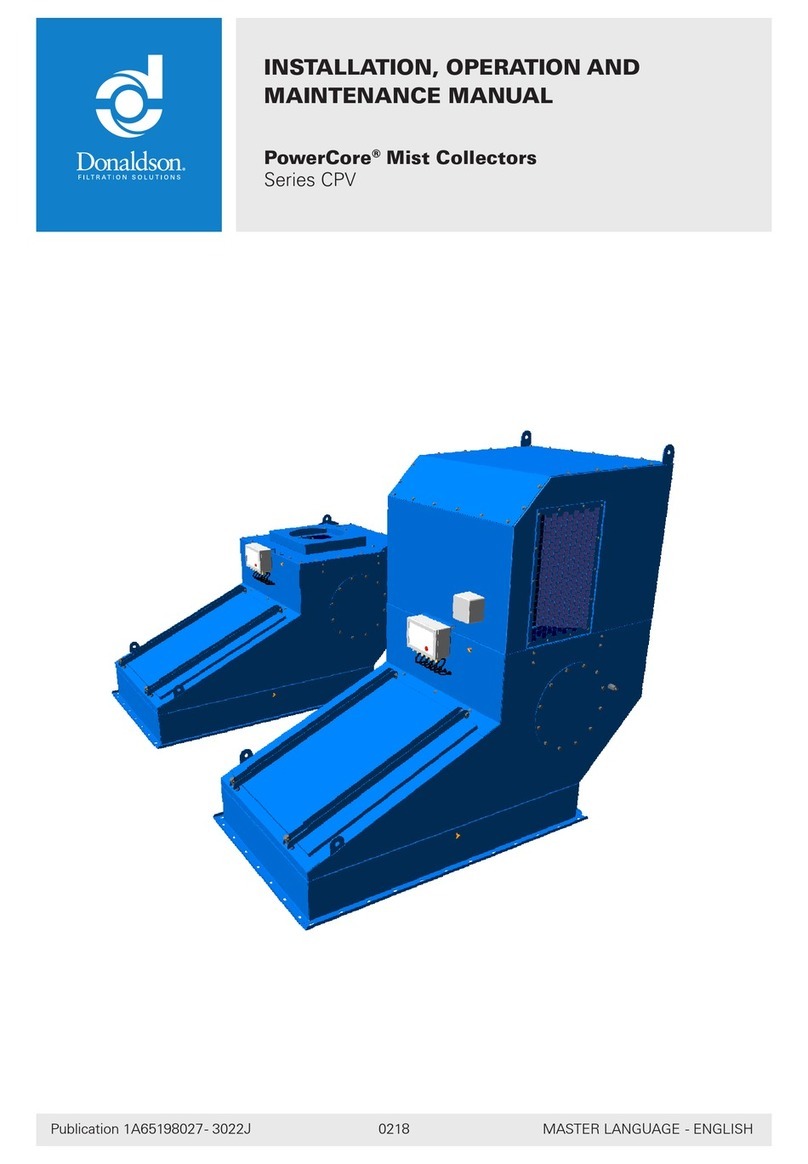
Donaldson
Donaldson PowerCore CPV Series Installation, operation and maintenance manual
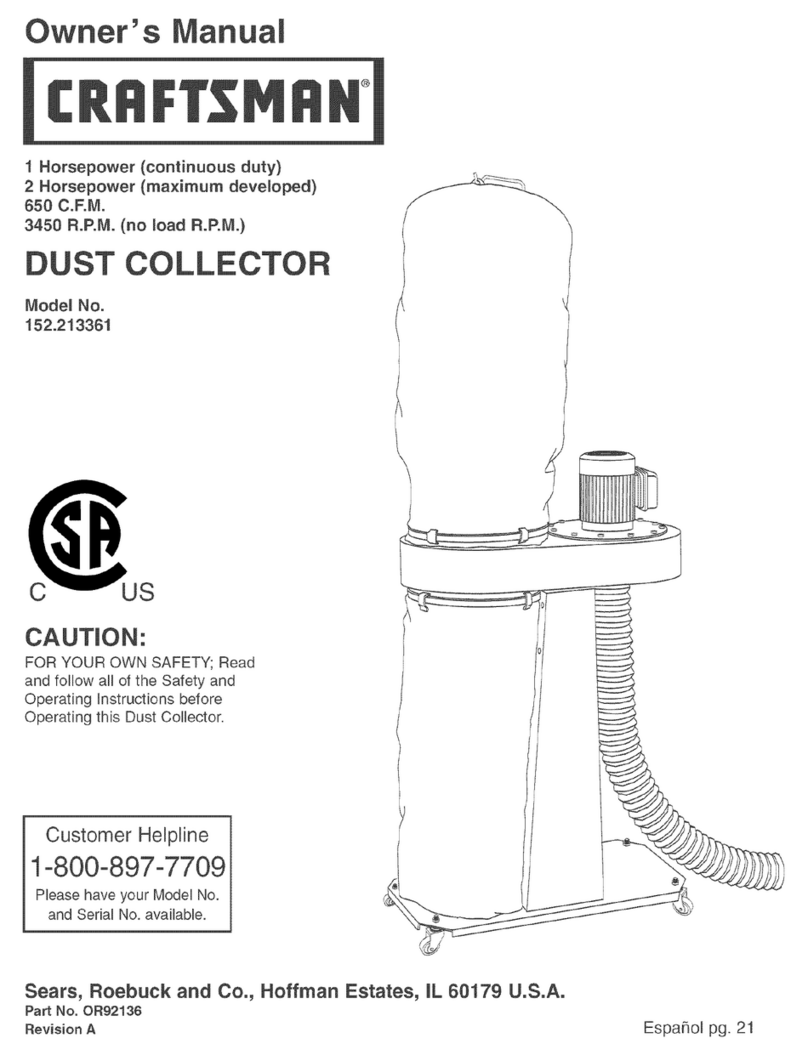
Craftsman
Craftsman 152.213361 owner's manual
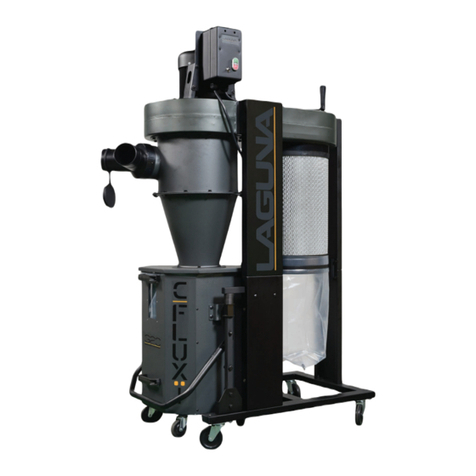
laguna
laguna C FLUX 1 owner's manual

King Industrial
King Industrial KC-4043KWRC Service manual
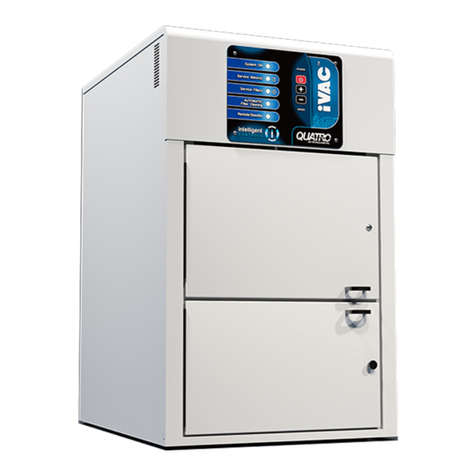
Quatro
Quatro Premium iVAC Series Operation and maintenance manual
